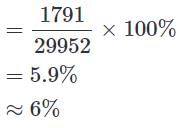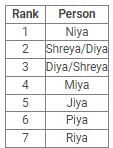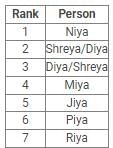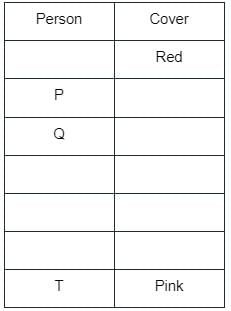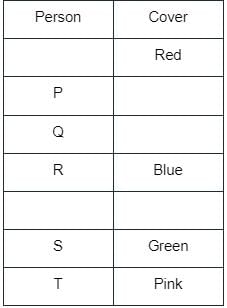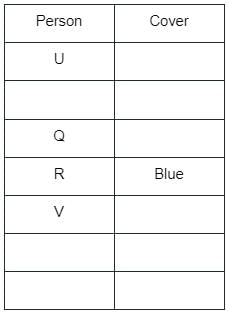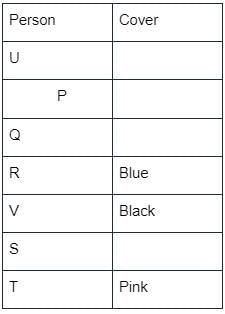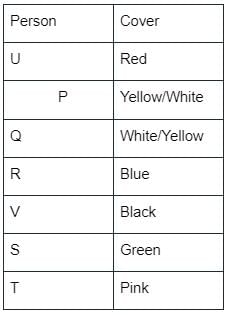SSC CGL (Tier II) Practice Test - 19 - SSC CGL MCQ
30 Questions MCQ Test - SSC CGL (Tier II) Practice Test - 19
Directions: Study the following information carefully and answer the questions given beside.
Aman, Binoy and Chintu are three friends who go out to explore the city. They ate their breakfast, lunch and dinner in the market and split the total bill. The amount spent by Aman on breakfast and lunch is in the ratio 3 : 4, while that spent by Chintu on lunch and dinner is in the ratio 11 : 7.
The amount paid by Aman on Dinner and Chintu on breakfast is equal. In lunch, the share of Binoy is the average of Aman and Chintu. The money spent by Aman on Breakfast and lunch is 700/9% of the money spent by Chintu on lunch and dinner. The ratio of breakfast, lunch and dinner in the total bill is 58 : 57 : 65. In the end Aman gives Chintu Rs. 20, to make the share of each of them equal.
Q. What is the ratio of amount spent by Aman on breakfast and dinner to the amount spent by Chintu on breakfast and dinner?
Aman, Binoy and Chintu are three friends who go out to explore the city. They ate their breakfast, lunch and dinner in the market and split the total bill. The amount spent by Aman on breakfast and lunch is in the ratio 3 : 4, while that spent by Chintu on lunch and dinner is in the ratio 11 : 7.
Directions: The following pie-chart shows the sources of funds to be collected by the National Highways Authority of India (NHAI) for its phase II projects. Study the pie-chart and answer the following three questions:
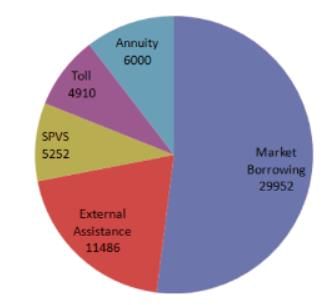
Q. If NHAI could receive a total of Rs. 9,695 crores as External Assistance, by what percent (approximately) should it increase the market Borrowing to arrange for the shortage of funds?

Directions: Study the pie-chart and table given below and answer the questions.
Details of the percentage of employees working in various departments in an organization and number of males among them.
Total number of employees = 800.
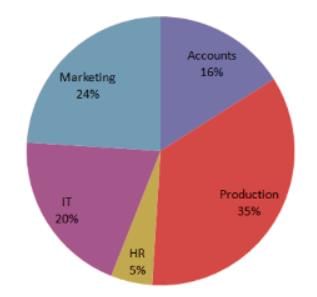
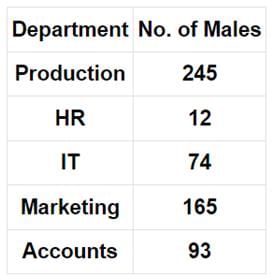
Q. The ratio of number of males in marketing department to the number of females working in that department is:
Details of the percentage of employees working in various departments in an organization and number of males among them.
Total number of employees = 800.


What is A’s position from the right end in a row of 30 students?
I. A is third to the right of B, who is twelfth from the right end.
II. H is 14th from the right end of the row and there are eight students between H and A.
Directions: Study the information below carefully.
A number arrangement machine, when fed with an input, rearranges the numbers following a particular rule.
The following is an illustration of input and rearrangement:
Input: 25010 7650 432 909 850 70 100 612
Step I: 432 25010 7650 909 850 70 100 612
Step II: 432 612 25010 7650 909 850 70 100
Step III: 432 612 70 25010 7650 909 850 100
Step IV: 432 612 70 850 25010 7650 909 100
Step V: 432 612 70 850 909 25010 7650 100
Step VI: 432 612 70 850 909 7650 25010 100
Step VII: 432 612 70 850 909 7650 100 25010
Step (VII) is the last step of the rearrangement.
Based on the above illustration, answer the questions regarding the given input:
Input: 78050 1650 266 1001 80 701 600 121
121 266 80 701 1650 78050 600 1001
Q. Which step of the arrangement yields the given output?
Directions: Read the given information carefully and answer the questions given beside:
Nine persons – Chaya, Dimple, Beena, Ajit, Jaya, Fatima, Gagan, Hemant and Kaushal – are sitting in a straight line facing north, but not necessarily in the same order.
Beena is fourth to the left of Gagan; Fatima is fourth to the right of Chaya and second to the left of Kaushal, who is fifth to the right of Ajit. Dimple is not an immediate neighbour of either Kaushal or Beena. There are only three persons between Jaya and Ajit. Gagan is second to the right of Chaya.
Q. Who among the following sits third to the left of Jaya?
Directions: Study the following information carefully and answer the questions given beside:
A teacher made an observation on the basis of the ranks of seven students – Piya, Riya, Shreya, Niya, Diya, Miya and Jiya, in the previous exams taken by them.
The observations were:
- No two students get same rank.
- Jiya always performs better than Piya.
- Piya always performs better than Riya.
- Each time either Shreya tops the class and Diya gets the last rank, or alternatively Niya tops the class and either Miya or Riya gets the last rank.
Q. If Riya is ranked fourth and there are two persons ranked between Jiya and Shreya then what is the rank of Miya?
Directions: Study the following information carefully and answer the questions given beside:
A teacher made an observation on the basis of the ranks of seven students – Piya, Riya, Shreya, Niya, Diya, Miya and Jiya, in the previous exams taken by them.
The observations were:
- No two students get same rank.
- Jiya always performs better than Piya.
- Piya always performs better than Riya.
- Each time either Shreya tops the class and Diya gets the last rank, or alternatively Niya tops the class and either Miya or Riya gets the last rank.
Q. If Niya ranked first and Riya is not holding last rank, then what is the rank of Diya if Jiya stood at 2nd?
In a classof 180, where girls are twice the number of boys. Ritesh a boy ranked thirty fourth from the top. If there are eighteen girls ahead of Rupesh how many boys are after him in rank?
Praise for Johnny Starstruck and his entourage are common, although statisticsshow Americans still associate his name with the ritualistic murders.
If seriously mentally ill people do not receive medication, they can grow unable tosupport themselves, become irrational, and perhaps even threatening the safetyof themselves or others.
If sentence (3), 'In most economic systems, the prices of the majority of goods and services do not change over short periods of time' is the first sentence, what is the order of other sentences after rearrangement?
1. In some, it is of course possible for an individual to bargain over prices, because they are not fixed in advance.
2. When planning his expenditure, he must therefore accept these fixed prices.
3. In most economic systems, the prices of the majority of goods and services do not change over short periods of time.
4. A consumer will go on buying bananas for as long as he continues to be satisfied.
5. If he buys more, he shows that his satisfaction is still greater than his dislike of losing money.
6. In general terms, however, the individual cannot change the prices of the commodities he wants.
Direction: In the questions given below a sentence is given with two blanks in each. Corresponding to each question two columns are given with three words in each column. Which combination of words from the two columns will perfectly fit into the blanks to make the sentence contextually correct and meaningful?
IIT-Bombay has been ______________ India’s best university for the second year in a row, ___________ a global ranking of 152 in the QS World University Rankings for 2020.

Directions: Read the passage and answer the questions that follow:
The deadline for the completion of the resolution process under the Insolvency and Bankruptcy Code (IBC), 2016 for the first set of cases taken up has neared or even passed. The IBC provides for a time limit of 180 days (extendable by 90 days) once a case of default is brought and If no resolution plan drawn up under the supervision of a resolution professional can be agreed upon, liquidation must follow to recover whatever sums are possible. While the NCLT has considered a number of cases since its constitution, its role assumed importance when, on 13 June 2017, the Reserve Bank of India (RBI) mandated proceedings against 12 large defaulters, holding accounts with outstanding amounts of more than Rs 5,000 crore, of which at least 60% had been classified as non-performing as of 31 March 2016. These bad loans accounted for around 25% of the non-performing assets (NPAs) recognised at that time.
In most cases, the estimated value of assets on liquidation is low, and does not capture the true value of the company. Put simply, the aggregate of the individual value of a set of stripped assets tends to be much lower than the value of those assets when combined for production. So, if the IBC process and the intervention of the NCLT lead, through bidding, to an offer of a takeover by a third party which is acceptable to the creditors, the recovery against bad loans technically written off by financial creditors would be much higher. Since this was to occur in a time-bound fashion, it seemed to be a significant initiative to address the NPA problem in the banking system. The IBC was combined with legislative amendments that strengthened the powers of the RBI to order the launch of proceedings to recover the loans gone bad. These measures, it was argued, through enforced resolution or liquidation if necessary, offered a way in which the abysmal record of recovery could be corrected and the pressure on the government to bail out banks with taxpayers’ money could be reduced. In the case of 11 public sector banks out of a total of 21, of the loans technically written-off between April 2014 and December 2017, recovery rates varied from nil to just above 20%, and in the case of another three, the rate ranged between 23% and 29%. The average recovery rate for all 21 banks was a pathetic 10.8%. By facilitating and accelerating the recovery effort, the IBC process was expected to raise the rate significantly.
The context in which this new strategy was launched needs recalling. Unlike the period prior to the 1990s, the NPAs that accumulated in the books of banks in recent years were not equitably distributed across different categories of borrowers, big and small, priority and non-priority. Rather, because of a change in the lending strategy during the period of the credit boom after 2003, the NPAs are now concentrated in the hands of large borrowers, primarily corporate borrowers.
The initial experience with the first phase of this multistep process involving the recognition, technical write-off and provisioning, and recovery of NPAs, is revealing for a number of reasons. First, in cases where the assets on offer were of special interest to particular bidders, the rates of recovery have been rather high. This was true of the acquisition of Bhushan Steel by Tata Steel and of Electrosteel by Vedanta. Bhushan Steel owed its financial creditors around Rs 56,000 crore, whereas the Tata Steel bid returned Rs 35,200 crore upfront to the financial creditors, besides giving them a 12.3% stake in the company in lieu of returning the remaining debt. That was substantial relative to the estimated liquidation value of Rs 15,000 crore to Rs 20,000 crore, and far better than the average 10% recovery rate reported on aggregate write-offs in the recent past. The Tatas clearly had a special interest in the deal since its valuation of the company was far higher than that of JSW Group, the other keen bidder. The latter offered the creditors only Rs 29,700 crore.
The evidence that the assets were valuable despite the defaults emerged also from the battle between bidders who were often taken to the courts. Essar Steel, one of the largest defaulters with around Rs 44,000 crore in questionable debt, when put up for sale, elicited expressions of interest from five bidders. Interestingly, besides Tata Steel, Arcelor Mittal, Vedanta, Sumitomo, and Steel Authority of India, the interested parties include the Ruias, who are the original promoters of Essar Steel.
This effort of the defaulting promoters to regain control of the companies concerned at a discount did muddy the water. The original IBC bill did not prevent promoters from making bids for resolution at the NCLT. Some justified the Ruia bid on the grounds that extraneous factors may have led to distress for no fault of the original promoters. But, if the Committee of Creditors (CoC) has taken the firm to the NCLT, it is clearly because they saw the incumbent management as incapable of resolving the crisis faced by the firm. And, if promoters regain control, much of the debt their company owes will be forgiven, with the losses being carried by the financial and operational creditors. Recognising the travesty involved, the government was forced to amend the IBC bill to prohibit promoters from bidding under the NCLT process.
Q. What was the experience of the IBC process for companies which were of special interest to bidders?
I. The rate of recovery was much better than the average recovery rate.
II. Competition between bidders to take over the defaulting company.
III. The liquidation value of the assets would have been higher than the recovered value.
Directions: Read the passage and answer the questions that follow:
Development is about expanding the capabilities of the disadvantaged, thereby improving their overall quality of life. Based on this understanding, Maharashtra, one of India’s richest States, is a classic case of a lack of development which is seen in its unacceptably high level of malnutrition among children in the tribal belts. While the State’s per capita income has doubled since 2004, its nutritional status has not made commensurate progress.
Poor nutrition security disproportionately affects the poorest segment of the population. According to NFHS 2015-16, every second tribal child suffers from growth restricting malnutrition due to chronic hunger. In 2005, child malnutrition claimed as many as 718 lives in Maharashtra’s Palghar district alone. Even after a decade of double digit economic growth (2004-05 to 2014-15), Palghar’s malnutrition status has barely improved.
In September 2016, the National Human Rights Commission issued notice to the Maharashtra government over reports of 600 children dying due to malnutrition in Palghar. The government responded, promising to properly implement schemes such as Jaccha Baccha and Integrated Child Development Services to check malnutrition. Our independent survey conducted in Vikramgad block of the district last year found that 57%, 21% and 53% of children in this block were stunted, wasted and underweight, respectively; 27% were severely stunted. Our data challenges what Maharashtra’s Women and Child Development Minister said in the Legislative Council in March — that “malnutrition in Palghar had come down in the past few months, owing to various interventions made by the government.”
Stunting is caused by an insufficient intake of macro- and micro-nutrients. It is generally accepted that recovery from growth retardation after two years is only possible if the affected child is put on a diet that is adequate in nutrient requirements. A critical aspect of nutrient adequacy is diet diversity, calculated by different groupings of foods consumed with the reference period ranging from one to 15 days. We calculated a 24-hour dietary diversity score by counting the number of food groups the child received in the last 24 hours. The eight food groups include: cereals, roots and tubers; legumes and nuts; dairy products; flesh foods; eggs; fish; dark green leafy vegetables; and other fruits and vegetables.
In most households it was rice and dal which was cooked most often and eaten thrice a day. These were even served at teatime to the children if they felt hungry. There was no milk, milk product or fruit in their daily diets. Even the adults drank black tea as milk was unaffordable. Only 17% of the children achieved a minimum level of diet diversity — they received four or more of the eight food groups. This low dietary diversity is a proxy indicator for the household’s food security too as the children ate the same food cooked for adult members.
Q. As per the passage, which of the following is/are needed for an adequate meal?
I. Macro and micro nutrients
II. Multiple food groups
III. High level of Intermittent fasting
Directions: Read the passage and answer the questions that follow:
Development is about expanding the capabilities of the disadvantaged, thereby improving their overall quality of life. Based on this understanding, Maharashtra, one of India’s richest States, is a classic case of a lack of development which is seen in its unacceptably high level of malnutrition among children in the tribal belts. While the State’s per capita income has doubled since 2004, its nutritional status has not made commensurate progress.
Poor nutrition security disproportionately affects the poorest segment of the population. According to NFHS 2015-16, every second tribal child suffers from growth restricting malnutrition due to chronic hunger. In 2005, child malnutrition claimed as many as 718 lives in Maharashtra’s Palghar district alone. Even after a decade of double digit economic growth (2004-05 to 2014-15), Palghar’s malnutrition status has barely improved.
In September 2016, the National Human Rights Commission issued notice to the Maharashtra government over reports of 600 children dying due to malnutrition in Palghar. The government responded, promising to properly implement schemes such as Jaccha Baccha and Integrated Child Development Services to check malnutrition. Our independent survey conducted in Vikramgad block of the district last year found that 57%, 21% and 53% of children in this block were stunted, wasted and underweight, respectively; 27% were severely stunted. Our data challenges what Maharashtra’s Women and Child Development Minister said in the Legislative Council in March — that “malnutrition in Palghar had come down in the past few months, owing to various interventions made by the government.”
Stunting is caused by an insufficient intake of macro- and micro-nutrients. It is generally accepted that recovery from growth retardation after two years is only possible if the affected child is put on a diet that is adequate in nutrient requirements. A critical aspect of nutrient adequacy is diet diversity, calculated by different groupings of foods consumed with the reference period ranging from one to 15 days. We calculated a 24-hour dietary diversity score by counting the number of food groups the child received in the last 24 hours. The eight food groups include: cereals, roots and tubers; legumes and nuts; dairy products; flesh foods; eggs; fish; dark green leafy vegetables; and other fruits and vegetables.
In most households it was rice and dal which was cooked most often and eaten thrice a day. These were even served at teatime to the children if they felt hungry. There was no milk, milk product or fruit in their daily diets. Even the adults drank black tea as milk was unaffordable. Only 17% of the children achieved a minimum level of diet diversity — they received four or more of the eight food groups. This low dietary diversity is a proxy indicator for the household’s food security too as the children ate the same food cooked for adult members.
Q. Which of the following strengthen the claim that the nutrition indicators fare poorly in India?
I. Stunting declined from 46.3% in 2005 to 34.4% in 2016.
II. As per an NHFS survey, wasting rates have increased from 16.5% to 25.6% over a period of 10 years.
III. The underweight rate (36%) has remained static in the last 10 years.
Directions: Read the passage and answer the questions that follow:
Development is about expanding the capabilities of the disadvantaged, thereby improving their overall quality of life. Based on this understanding, Maharashtra, one of India’s richest States, is a classic case of a lack of development which is seen in its unacceptably high level of malnutrition among children in the tribal belts. While the State’s per capita income has doubled since 2004, its nutritional status has not made commensurate progress.
Poor nutrition security disproportionately affects the poorest segment of the population. According to NFHS 2015-16, every second tribal child suffers from growth restricting malnutrition due to chronic hunger. In 2005, child malnutrition claimed as many as 718 lives in Maharashtra’s Palghar district alone. Even after a decade of double digit economic growth (2004-05 to 2014-15), Palghar’s malnutrition status has barely improved.
In September 2016, the National Human Rights Commission issued notice to the Maharashtra government over reports of 600 children dying due to malnutrition in Palghar. The government responded, promising to properly implement schemes such as Jaccha Baccha and Integrated Child Development Services to check malnutrition. Our independent survey conducted in Vikramgad block of the district last year found that 57%, 21% and 53% of children in this block were stunted, wasted and underweight, respectively; 27% were severely stunted. Our data challenges what Maharashtra’s Women and Child Development Minister said in the Legislative Council in March — that “malnutrition in Palghar had come down in the past few months, owing to various interventions made by the government.”
Stunting is caused by an insufficient intake of macro- and micro-nutrients. It is generally accepted that recovery from growth retardation after two years is only possible if the affected child is put on a diet that is adequate in nutrient requirements. A critical aspect of nutrient adequacy is diet diversity, calculated by different groupings of foods consumed with the reference period ranging from one to 15 days. We calculated a 24-hour dietary diversity score by counting the number of food groups the child received in the last 24 hours. The eight food groups include: cereals, roots and tubers; legumes and nuts; dairy products; flesh foods; eggs; fish; dark green leafy vegetables; and other fruits and vegetables.
In most households it was rice and dal which was cooked most often and eaten thrice a day. These were even served at teatime to the children if they felt hungry. There was no milk, milk product or fruit in their daily diets. Even the adults drank black tea as milk was unaffordable. Only 17% of the children achieved a minimum level of diet diversity — they received four or more of the eight food groups. This low dietary diversity is a proxy indicator for the household’s food security too as the children ate the same food cooked for adult members.
Q. Which of the following is/are true as per the passage?
I. India’s situation is worse than in some of the world’s poorest countries — Bangladesh, Afghanistan or Mozambique.
II. Development is more than just economic growth.
III. On an average, the nutrition expenditure as a percentage of the Budget has drastically declined from 1.68% in 2012-13 to 0.94% in 2018-19.
Directions: Out of the given alternatives, choose the one which can be substituted for the given words/sentence.
A person who has no money to pay off his debts
Directions: Out of the given alternatives, choose the one which can be substituted for the given words/sentence.
A person who is womanish in his habits
Seven books of different subjects viz. P, R, V, S, Q, U and T have different colors of cover Red, Green, Blue, Black, White, Yellow and Pink are kept one above other on the self then, then how many books is/are kept between Yellow covered book and V book?
I. T is kept at the bottom having pink cover. There is a gap of one place between R and S, which has the cover of Green color. P is at the second position from the top. Book having Red cover is kept at the top. R having Blue cover is above S. Q book is kept just below P book.
II. V is kept third from the bottom just below R having Blue cover. U book is kept on top at a gap of one place from the Q book. V book having Black cover is kept at any place below P book. T book having Pink cover is kept at any place below S book.
Read the each sentence to find out whether there is any grammatical error in it. The error, if any will be in one part of the sentence. The letter of that part is the answer. If there is no error, the answer is 'D'. (Ignore the errors of punctuation, if any).
Motivating employees with traditional authority and financial…(11)….has become increasingly…(12)… as employees become economically secure and their dependency on any one particular organisation…..(13)…. . According to expectancy theorists, the motivation to….(14)…increases when an employee feels his…(15)… is an instrument for obtaining desired rewards. Nevertheless, in many organisations today employees are….(16)… to organizational rewards just by being employed. Unions, governmental regulations, and the nature of the job itself in some cases…..(17)… management from …..(18)… financial rewards to performance. People may be attracted to join and remain in organisations to receive organizational rewards, but…(19)…motivated to join an organisation is…(20)..the same as being motivated to exert effort in an organisation.
Q. Find the word most appropriate for Blank No. 12
Motivating employees with traditional authority and financial…(11)….has become increasingly…(12)… as employees become economically secure and their dependency on any one particular organisation…..(13)…. . According to expectancy theorists, the motivation to….(14)…increases when an employee feels his…(15)… is an instrument for obtaining desired rewards. Nevertheless, in many organisations today employees are….(16)… to organizational rewards just by being employed. Unions, governmental regulations, and the nature of the job itself in some cases…..(17)… management from …..(18)… financial rewards to performance. People may be attracted to join and remain in organisations to receive organizational rewards, but…(19)…motivated to join an organisation is…(20)..the same as being motivated to exert effort in an organisation.
Q. Find the word most appropriate for Blank No.17
Which of the following is appointed by the President?
_______ is the process in which acids and bases react to form salts and water.
Choose the incorrect statement from given below.
Which of the following is sometimes called Chips or microchips?
The device used to fetch (or bring) instructions and data into a computer system is called ___________.
The attributes and methods for each object are stored in.





